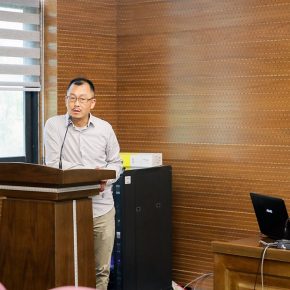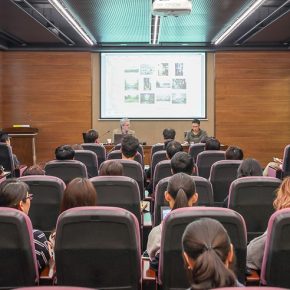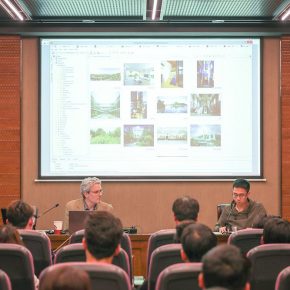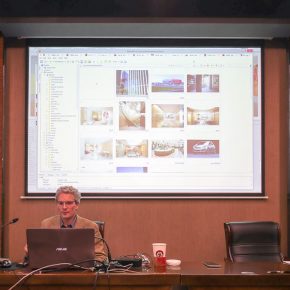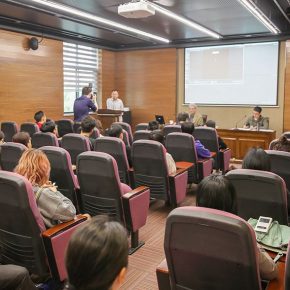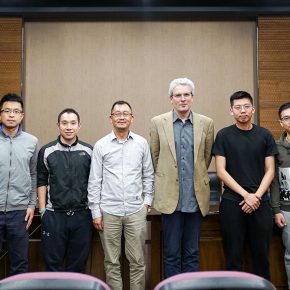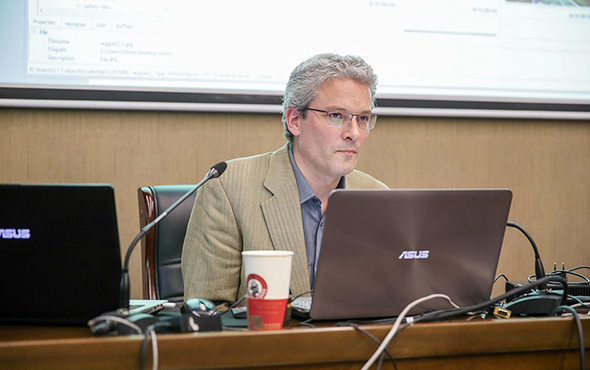
A lecture of “Introduction of the State of the Art of Computer Graphics: Status, Achievements and Future” was held by CAFA Visual Art Innovation Institute at Building 14 #309 at 6:00 pm on 18 April 2018. It was hosted by a professor from the Department of Photography, Wang Chuan, and an expert in 3D vision and rendering solutions, and the CEO of the FELIX Render, David Rossmann, was the presenter. David used some practical cases to introduce the development history of Computer Graphics, the current application and the possibility for the future. He also gave his profound opinion on the classic problem – “the relationship between art and technology”.
First of all, Prof. Wang Chuan introduced David Rossmann as a real master of Computer Graphics, and stated that he was also an excellent teacher. He is an expert involved in large-scale image acquisition and data platform projects in “Visual Memory of Tongzhou” which was initiated by CAFA Visual Art Innovation Institute, and the technical standards and professional ability are very impressive. David attaches great importance to the control of the relationship between technology and art. He has always maintained a lead and control in technology, and constantly examines technology and media while benefiting from technology.
In the lecture, David Rossmann first described how he started in the field of Computer Graphics. David was originally an artist, and he studied at an art college in Italy in the early 1990s. He comes from a family of artists, though he actually lacked a background in technical teaching. When he was younger, he was a lighting consultant, who designed lighting for museums, churches and apartments, during this period he had to explain the difficulties of lighting design and operation to customers. After conducting a short study, he discovered that the first Computer Graphics application in the world was actually created to simulate a modified lighting environment, he then persuaded his boss to purchase the software and started to discover how to modify lighting and adjust lighting sets. A few years later, David switched from lighting design to architectural design. His company began to independently develop software and was very successful in early 2000. From 2004, he started working together with internationally renowned architectural design studios and architects such as Zaha Hadid, Jean Nouvel. He then used many photos to share with the audience part of his work and achievements.
David Rossmann briefly reviewed the history of the development of Computer Graphics, starting from the prototype of light pen invented in the 1950s, the first video game invented in 1961, the invention of Bezier curves, the first object which was reproduced with the use of 3D rendering in 1971 and the invention of the 3D scanner at a low-cost and affordable computers appeared in the market in the 1980s, the emergence of computer games on a big scale, the research and development of the first 3D modeling software applying a human friendly computer interaction, and then the global lighting technology and the low-cost 3D modeling software were widely used in the 1990s. David showed the audience a development context of Computer Graphics. In his opinion, the development of Computer Graphics has always been dominated by technical experts. The hardware has been developed since 2000, but there is not any substantial innovation or progress in the content. It is because Computer Graphics are monopolized by big companies. David is interested in a computer image learning application developed by Google. Applying the principle of an adversarial network, it uses a lot of material to train a computer to recognize the semantic content of images, so that it is able to autonomously generate semantic images.
Will Computer Graphics offer people other possibilities? David Rossmann used many cases to tell us about the application of Computer Graphics in an architectural concept design, vehicle design, electronic product design, furniture design and even microscope imaging so the computer is irreplaceable in the generative design. Because this technology is widely used, the cost of design and production has been greatly reduced, it also offers a brand-new choice to post-production of film. The film relies more on computer imaging than other categories of art. It is necessary for painting to satisfy the people who are of a discerning visual perception, while people often use low-cost images in the production of films in order to save money, but it cannot enhance the artistic creativity. David hopes that artists can discover different inventions, and use the powerful Computer Graphics to enhance artistic creativity, rather than misusing them, such as using them in order to reduce costs.
David said that the founder of Pixar John Lasseter was a person who used the powerful functions of Computer Graphics to achieve his artistic pursuits and he then showed his short film. David stressed that we could be interested in technology and immerse ourselves in the study of it but we could not lose ourselves. We must tell a good story in order to avoid losing ourselves in technology. Many people are fascinated by technology itself, and they become slaves to technology. Technology should become a tool for you to tell a story in your mind and a good story or a good idea will not disappear even if this technology is replaced or disappears. David took the case of the Norwegian architectural design company “MIR.” to expound on his idea. He believes that each graphic and structure they design contains a storyline, integrating a historical charm and ideology and the idea and narrative of the work makes their value exceed the production cost. Art is much more important than technology itself. It is also a truth in other fields, and rather than technologies, people who create and use technologies produce exquisite results. In fact, it is easy to grasp a technology, while the inherent sensitivity and creativity is what the art students should look for and maintain, which makes us own more things that are worth the wait when investing in software.
Text by Zhang Chi, translated by Chen Peihua and edited by Sue/CAFA ART INFO
Photo courtesy of the organizer


